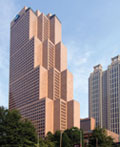In mid-2011, noted roofing technologist Bill Clinton wrote a piece for Newsweek in which he outlines a 14-point plan for creating jobs in the U.S. No. 8 on the list is the idea to "paint 'em white." "Painting" (his word) roofs white, he argues, not only would help solve our energy problems but also would create jobs that wouldn't otherwise be created.
In the article, he argued painting "tar" roofs white in major U.S. cities would reduce the "utility bill in every apartment house 10 to 20 percent" yet offered no evidence where that calculation came from. (And he offered no evidence of how, for example, someone living on the 20th floor of a 30-story apartment building in New York is supposed to realize savings from all that white paint.)
Clinton went on to say jobs for this kind of "simple" work would be plentiful (costs can be recovered in a week!) and suitable for "kids" who could parlay this skill into energy-related retrofit jobs. I wonder whether Clinton consulted with the building trades unions about this swell idea.
Subsequently, a group calling itself the White Roof Project has embraced the former president's idea and assembled a "progressive group of young people" to start painting roofs.
According to the White Roof Project: "Volunteers saw that all it takes is a paint roller, some solar-reflecting white coating and a little hard work to start curbing climate change."
And maybe if you rub the paint roller three times, a genie will appear, too.
Once you get past the inanity of it all, you begin to realize there is a conclusion to be drawn from all this nonsense, namely we need to make decisions based on good science rather than seat-of-the-pants ideas. We all want to see homes and buildings made more energy-efficient, but, as we continually learn, there always are trade-offs.
More roof insulation generally is a good thing—but there is a point of diminishing returns. Rooftop solar systems generally are good things—provided they meet wind and fire requirements and are installed to protect the roof system's integrity. And yes, reflective roof surfaces generally are good things—but not ones coated with "paint," without maintenance programs, and installed by "kids" who may not meet child-labor laws and who, evidently, receive no safety training. (Where, by the way, is the Occupational Safety and Health Administration when we need it?)
I can think of no better example of the axiom that simple solutions breed complicated results. We can—and must—do better than this.
Bill Good is NRCA's executive vice president.



